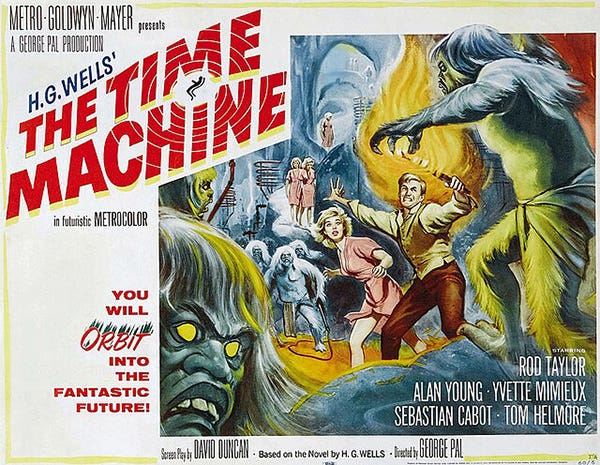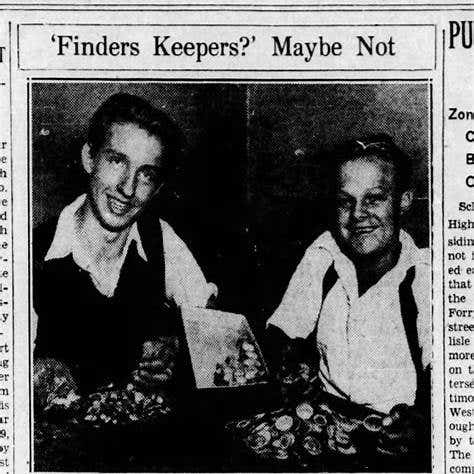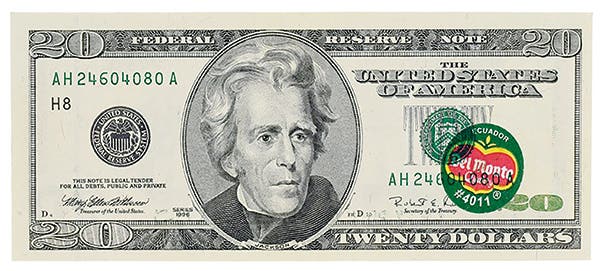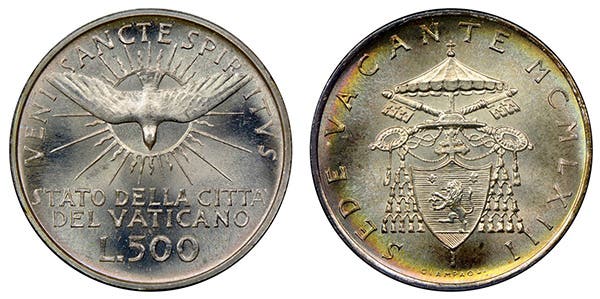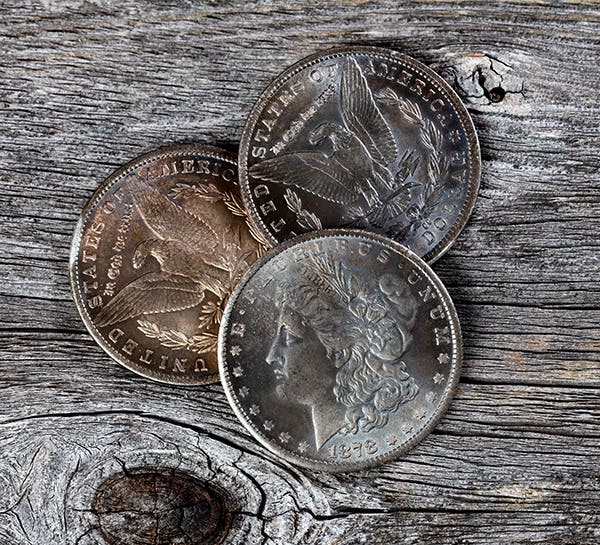This week’s letters (10/25/11)
I wanted to drop you a line to say thank you for the 30th anniversary proof set I won in 1982 as a YN at a local coin show in Lanham, Md.
YN win still saved and appreciated, 30 years later
I wanted to drop you a line to say thank you for the 30th anniversary proof set I won in 1982 as a YN at a local coin show in Lanham, Md. I had been going through some old boxes and discovered the award letter (I have the coins stashed away in their original package). It is hard to believe it’s been 30 years. I just wanted to let you know I still have the set and the congratulations letter. Happy 60th anniversary in 2012.
Paul Ringley
Address withheld
Circulating 2009 cents proving impossible to find
I have looked through hundreds of rolls of Lincoln cents. I have found a total of one 2009 Lincoln cent. Where have they all gone? Even if you look at a lot of the dealers’ stocks, they are not offering except at out-of-sight prices. They have made billions of coins. Are there dealers with unlimited resources to dry up the 2009 Lincoln cent supply? Are there any other collectors that have found this to be or am I alone? Thanks for listening.
Leo Rishty
Weston, Fla.
Silver’s plunge makes for dismaying Eagle purchase
After buying four of the 2011-W uncirculated silver Eagles at a price of $60.45 each plus shipping from the U.S. Mint, the price of silver dropped from over $40 an ounce to $30 an ounce. The website is now closed for a price adjustment, probably an increase. A fair price to the collectors should have been no more than $40. With silver still tumbling, all buyers of U.S. Mint products are taking it in the shorts.
I would return the silver Eagles if I knew I would get my money back. The U.S. Mint would probably say, “Sorry, we didn’t receive them.” The Mint should adjust their prices lower and give a credit back to the purchasers.
Marco Ramius
El Paso, Texas
Figures provided from Mint robbery don’t add up
I read that William Gray was charged with stealing $2.4 million in dollar coins from the Philadelphia Mint. “Wow!” I said. “How would you carry out that many coins?” Then I read in David Ganz’s column that perhaps about 32,000 coins were removed. It’s been a long time since high school, but 32,000 x $1 = $32,000. Whether he sold them for $75 each or $2 each, that doesn’t change the face value. If, hypothetically, he had hoarded them to sell later, they would “only” be worth $32,000 – true? Talk about changing the terms to suit the situation.
Rick Notkin
Canton, Mass.
Gold and silver plunge presents many challenges
Gold and silver price suppression is real. Read what Patrick A. Heller wrote on Numismaster.com on Sept. 27.
The COMEX (a regulated commodity exchange) raised margin requirements after the price of gold had already fallen 6 percent and silver was down 20 percent from April.
This is a new “classic” example of price suppression. This action defies the convention of trying to maintain orderly markets. It is like pushing on the accelerator after the brakes have failed. And this action likely caused increased selling, which will result in Uncle Sam getting a big tax slice of the long term gold and silver profits. This is especially true with profits from any long term holders who had sizeable automatic protective trailing stop orders to sell after drops as large as 15 percent in the SPDR Gold Trust (Ticker: GLD) exchange traded fund. This fund peaked at 185.85 in August and closed at 156.22 at the end of regular trading hours on Sept. 28.
The iShares Silver Trust (SLV) peaked at $48.25 in April and closed at $28.87 at the end of Sept. 28. This is a 40 percent price correction. Most of the drop occurred on just two days, Sept. 22-23. Both days opened with price gaps down. The total price drop for those two days was 22.25 percent. This may have a detrimental effect on the rare coin market also.
Some coin dealers who bought silver at over $36 and gold at over $1,700 an ounce may now be financially hurting.
If prices continue to fall, then trying to stop the market drop is like trying to catch falling knives. One should only buy bullion with money one can afford to lose part of and have protective loss stops if bought in an exchange traded fund (e.g., GLD or SLV; possibly with a stop of 8 percent or less) in a falling market.
Or better yet, buy after an upturn, but still be prepared to be stopped out. Or wait for the end of two consecutive down months and then buy with a protective stop. In the case of buying either cash and carry bullion or collector coins, it may be wise to wait until there has been a reversal upwards in price after the first purchase if it was made following a two-month price dip.
Remember: your first loss is always your best loss. Between 1990 and 1997, certified Mint State U.S. collector coins mostly fell in price. Many coin series have not yet recovered from those dips. If gold and silver get their prices cut like they did in 1980, then it could be months or years before they recover sufficiently.
Gerald Perman
California
Sept. 11 medal delivery method appears wasteful
On July 24, I ordered three 2011-W Sept. 11 silver medals (S11) and two 2011-P Sept. 11 silver medals (S12). Then, on Aug. 17, I ordered three more 2011-P medals, and two more 2011-W medals. This gave me a total of 10, five 2011-P medals and five 2011-W medals, with paperwork to follow. The other day, I received two packets from PBGS, 2799 Reeves Road, Plainfield, IN 46168, with one copy of each medal. That gives me only two of the 10 that I should get.
Now, this raises a question. Why wouldn’t all 10 come in one envelope, or since I ordered two times, five in two? Please don’t tell me I will get 10 envelopes containing one each.
I thought the Mint is trying to save money. Even though I ordered on two different dates, the item was back-ordered until Sept. 1 and both items could have been consolidated in one shipment. But I guess it is just easier to waste taxpayers’ dollars. The coins are beautiful and were minted for a good cause. There is a phone number on the envelope. I guess I will call to explain the problem.
Daniel Kuziela
Chicago, Ill.
Difference in double lettering as error
Why are the Washington and Adams dollars with no lettering on the edges listed in most publications as errors, yet the “doubled lettering” both overlapped and inverted on the John Adams dollar are hardly ever mentioned? It seems the doubled lettering is more of an error than the missing letters.
Al MagninAddress withheld
Editor’s note: Collector tastes play a large role in what is considered to be significant. Lincoln cents are more popular than 2-cent pieces. Plain edge Presidential dollars are considered superior to doubled lettering. Relative scarcities also play a role.
Mint changes certificate policy for medal
I had purchased four 2011 Sept. 11 medals from the Mint (two 2011-P and two 2011-W).
The medals were received early this month just fine, even ahead of expected date. However, I received an email from the Mint that the corresponding certificates would be sent later.
Yesterday, I received a large envelope with one certificate, which was nicely packaged with a piece of cardboard. However, I should have received four certificates.
I called the Mint’s toll-free line, and the customer service rep was quite helpful and said that three more would be sent. She also said that regardless of the number of medals purchased, only one certificate was being sent unless the purchaser calls the toll-free number and requests the correct number. I thought Numismatic News readers would like to know.
Odd, isn’t it? First, that the certificates were not ready even though the pre-sale on the medals was over a month earlier. Thus, it becomes an added expense to send them separately.
Second, that purchasers need to call to request the correct number of certificates.
Third, that the certificates are glossy 8.5 x 11, not really convenient to keep with or in the medal boxes.
Keith Bock Rochester, N.Y.
Let Kennedy halves end in 50th year
I think the term abolished might be a little strong for the Kennedy half dollar. Perhaps we need to start a retirement count down for it, say in three years. Make its last year 2014, its 50th anniversary. Who knows, it might get some new collector going trying to collect the entire set.
Gary White Lenexa, Kan.
Collecting Lincoln cents brings joy
I have recently rekindled my love for Lincoln cents and resumed searching rolls of them like I did 25 years ago. Upon reading your article in the Oct. 4 Numismatic News, I had to share my feelings about the truly simple joy I feel when I come across a brilliant shiny penny that is 20, 30, 40, 50 or even 60 years old. Not only does it thrill me, but it amazes me that these particular pennies have survived in that condition for so long in circulation.
My greatest find, up to this date, has been a 1955-S in Mint State condition! Upon finding it, I ran downstairs to show one of my sons. His reaction: “Neat!” I then went off to show my wife. Her reaction: “Can’t you see I’m on the phone?”
Obviously, they didn’t get it, but I did. It has inspired me even more to keep searching. Who knows, maybe I will come across that big prize penny one day.
Joseph P. Gerloff Norfolk, Va.
Sept. 11 commems just as meaningful as 2011 medal
I believe this era for medals is the dawning of a one shot deal. Sept. 11 was a very important event in the lives of all who are old enough to remember it and far-reaching enough to last the length of all of our lives.
Personally, it seems that the official Sept. 11 medal is a redundancy, since soon after the attack, I bought two of the many coins produced as “silver rounds” and they have served me well as remembrance “medals.” One is a commemorative of the New York firemen, which I added to my collection of memory tokens without having to spend double the price for an official medal. The bullion are my medals. The postage stamp memorial will serve as a supporting backup illustration along with my bullion silver to help maintain my aging memory right up to and including my deliverance.
Kenyon Miers
Esperance, N.Y.
Two dates on a 50-peso coin doesn’t indicate a fake
I have just read and reviewed the Oct. 11 issue of Numismatic News, noting among other things, the letter of Pete Perez of San Antonio, Texas, who spotted a fake Mexican 50-peso coin at a flea market. He stated, “The only odd thing about it was that it had two dates: 1821-1947.”
It is that statement that is “odd,” since every genuine Mexican 50-peso coin ever minted from 1921-1931 and from 1943-1947 has two dates: 1821 (representing the end of the Mexican War of Independence), plus the year the coin was minted (with the exception that some may have been minted after 1947, but retained the 1947 date regardless of a later mint date).
If the coin did not have two dates, it most certainly would be fake. But there is nothing “odd” about the fact it had “two” dates, one always being 1821.
Bill Deffebach
Houston, Texas
Miller wrongly defines ‘the twist’ in Oct. 11 NN
In the Oct. 11 Numismatic News’ ‘Coin Market at a Glance,’ Harry Miller said the ‘the twist’ operation by the Federal Reserve is where they ‘purchase longer term bonds instead of shorter term’ and that this is an inflationary move. He is wrong on both counts.
The ‘twist’ involves first selling short term securities and using the proceeds to purchase long term bonds. Aside from very minor discrepancies (since the trade is done at par), this in no way injects new money in the banking system and is in no way inflationary – which is precisely why the markets did not act like it was.
If there is anything I dislike more than leaving out all the facts it’s stating erroneous ones.
Steve Gregory
Schaumburg, Ill.



